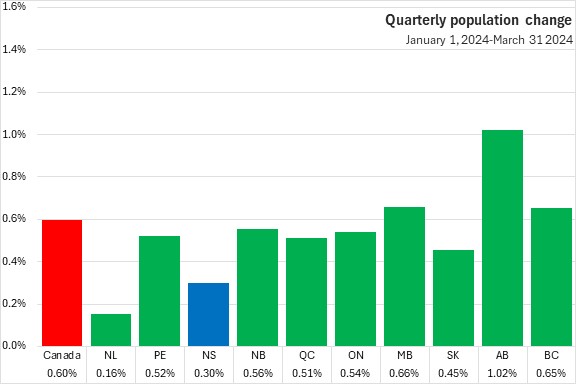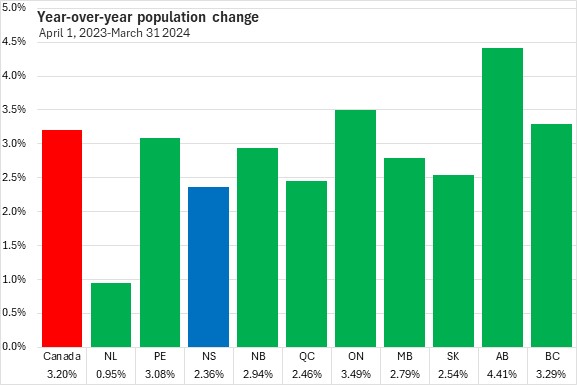The Economics and Statistics Division maintains archives of previous publications for accountability purposes, but makes no updates to keep these documents current with the latest data revisions from Statistics Canada. As a result, information in older documents may not be accurate. Please exercise caution when referring to older documents. For the latest information and historical data, please contact the individual listed to the right.
<--- Return to Archive
For additional information relating to this article, please contact:
June 19, 2024NOVA SCOTIA QUARTERLY POPULATION ESTIMATES AS OF APRIL 1, 2024 
Nova Scotia's population was 1,072,545 as of April 1, 2024. Nova Scotia's population increased by 3,181 (+0.30%) from January 1, 2024.
From January 1 to March 31, there were positive contributions to population growth from international sources as immigration (+3,999) was substantially higher than net emigration (-174) and the number of non-permanent residents entering Nova Scotia (+4,300) exceeded the number leaving the province (-4,011).
Natural change continues to put downward pressure (-738) on Nova Scotia's population as deaths (-2,811) outpace births (+2,073).
The number people moving away from Nova Scotia to another province or territory (-4,900) exceeded the number of Canadians moving into Nova Scotia from another province (+4,705). The net interprovincial outflow of 195 persons was the second net interprovincial outflow and the largest net outflow since 2015.
Nova Scotia's population growth from January 1 to March 31 was slower than in the same period in the previous three years, but remains elevated from growth observed prior to 2020 (2020 was distorted by pandemic-related restrictions on relocation).


From January 1 to March 31, 2024 Nova Scotia’s population increased 0.30%, while the national population grew 0.60%. All provinces reported increasing populations. Alberta reported the fastest population growth this quarter while Newfoundland and Labrador had the slowest growth (followed by Nova Scotia).

Year-over-year change
Compared with April 1, 2023, Nova Scotia's population increased by 24,742 (+2.36%). This was the eighth fastest year-over-year growth for Nova Scotia's population for any 12-month period of the quarterly data that started in 1951, and also marks the fourth consecutive period in which population growth slowed from the peak growth rate in January 1-March 31, 2023. Since ending a period of population decline on July 1, 2015 Nova Scotia's population has increased by 137,165.
Contributing to population growth from April 1, 2023 to March 31, 2024 were births (+8,483), immigrants (+11,870), non-permanent resident inflows (+27,288) and interprovincial in-migration (+20,830). These gains were partially offset by deaths (-11,071), net emigration (-497), departure of non-permanent residents (-14,751) and out-migrants to other provinces or territories (-17,410).

Over the previous 12 months, the national population grew by 3.20%. Nova Scotia's year-over-year population growth (+2.36%) was slower than every province except Newfoundland and Labrador (+0.95%). Over the last year, Alberta (+4.41%) reported the fastest population gain.

Nova Scotia's year-over-year population growth of 2.36% (+24,742) has decelerated from the recent peak recorded as of January 1-March 31, 2023 but remains among the fastest year-over-year growth rates since 1951.


Immigration from other countries has been a strong contributor to population growth in Nova Scotia in recent years. For the period January 1 to March 31, an additional 3,999 immigrants came to the province. This just edges ahead of July 1-September 20, 2021 (+3,998) as the largest quarter of immigration in records dating back to 1946. Over the past year (April 1, 2023 - March 31, 2024) 11,870 immigrants have arrived in Nova Scotia.

The net change in non-permanent residents in the province was added 289 persons to Nova Scotia's population between January 1 and March 31. The number of non-permanent residents arriving in Nova Scotia was 4,300 while 4,011 non-permanent residents left the province over the same time.
In the period April 1, 2023 to March 31, 2024 there was a net increase of 12,537 non-permanent residents in Nova Scotia.

The number of non-permanent residents arriving in Nova Scotia in the last four quarters was 27,288.

In the last four quarters, 14,751 non-permanent residents left Nova Scotia.

Nova Scotia’s natural population change (the number of births less the number of deaths) has been negative for several years. Between January 1 and March 31 there were 2,073 births and 2,811 deaths, amounting to a natural population decline of 738. Natural population decline in the first quarter of 2024 was smaller than that observed in the previous two years.
From April 1, 2023 to March 31, 2024 there were 8,483 births, which were outnumbered by 11,071 deaths, resulting in a natural population decline of 2,588.

A total of 4,705 new Nova Scotians arrived in the province from other parts of Canada between January 1 and March 31. Although this was above pre-pandemic population inflows from other provinces, it was less than during the same months of 2021, 2022 and 2023. From April 1, 2023 to March 31, 2024 there have been 20,830 interprovincial migrants arriving in Nova Scotia.

A total of 4,900 Nova Scotians left the province bound for other parts of Canada between January 1 and March 31. This was faster than the pace observed in the same months of any year since 2015. Over the past year, Nova Scotia has seen 17,410 interprovincial outmigrants.

From January 1 to March 31, Nova Scotia's net interprovincial migration generated a net outflow (-195) - the second net interprovicial population loss in the last three quarters and the largest decline since the same months of 2015. From April 1, 2023 to March 31, 2024 Nova Scotia's net interprovincial migration was still positive (+3,420).

Ontario continues to account for the largest number of in-migrants to Nova Scotia, however this pace is slowing. Migration from Ontario to Nova Scotia decreased from 3,640 between January 1, 2023 to March 31, 2023 to 2,506 from January 1, 2024 to March 31, 2024.
In-migrants were down (compared to the same period in 2023 ) from all provinces and territories except Newfoundland and Labrador, Prince Edward Island and Saskatchewan.

Ontario and Alberta were the largest destinations for those leaving Nova Scotia between January 1 and March 31 of 2024. Out-migration was up notably to both of these provinces, compared to the same months in 2023.

From January 1-March 31, Nova Scotia's net interprovincial migration was negative reflecting a large net inflow to Alberta (-794) as well as a substantial new outflow to New Brunswick (-263). Ontario (+789) was the only substantial net source of population gain.

For April 1 to March 31, 2024 the largest source of interprovincial in-migration was from Ontario (10,495), lower than in the previous year. In-migration was lower from all provinces and territories compared to the previous year except for Prince Edward Island and Manitoba.

From April 1 to March 31, 2024 the primary destinations for outmigration from Nova Scotia were Ontario and Alberta, followed by New Brunswick and British Columbia. Compared to the previous year, Nova Scotia out-migration increased for Quebec, Alberta, British Columbia and the Northwest Territories.

Ontario was the contributed the most substantial positive net interprovincial migration From April 1, 2023 to March 31 2024 (+4,291), followed by British Columbia (+295), Prince Edward Island (+266), Québec (+224) and Manitoba (+220). Alberta (-1,694) was the largest source of population loss among provinces and territories over this period, followed by New Brunswick (-266).

Non-permanent residents
The number of non-permanent residents in Nova Scotia has increased from 39,617 as of April 1, 2023 to 52,154 as of April 1, 2024. Non-permanent residents most often hold work permits (24,671), study permits (14,353), or both work and study permits (10,344).
Asylum claimants, both with and without study/work permits, were 419 as of April 1, 2024.
There were 2,367 other non-permanent residents which are generally family members living with permit holders or persons with temporary residents permits.

Non-permanent residents accounted for 4.9% of Nova Scotia's population as of April 1, 2024. Nationally, non-permanent residents make up 6.8% of the population with the highest shares in British Columbia (8.9%) and Ontario (7.8%) and lowest shares in Newfoundland and Labrador (2.7%) and Saskatchewan (3.2%).

For the period January 1 to March 31, 2024 the non-permanent resident population in Nova Scotia grew 0.6%, slowing for the second consecutive quarter.
Nationally, the non-permanent resident population was up 5.0% with the fastest growth in Alberta. Prince Edward Island and New Brunswick reported the only declines in non-permanent residents during this period.

The non-permanent resident population in Nova Scotia has increased 31.6% from April 1, 2023 to April 1, 2024.
Nationally, the non-permanent resident population increased 42.1% with the fastest growth in Alberta (+63.2%) and the slowest in Prince Edward Island (+18.8%).

Source: Statistics Canada. Table 17-10-0009-01 Population estimates, quarterly; Table 17-10-0020-01 Estimates of the components of interprovincial migration, quarterly; Table 17-10-0040-01 Estimates of the components of international migration, quarterly; Table 17-10-0045-01 Estimates of interprovincial migrants by province or territory of origin and destination, quarterly; Table 17-10-0121-01 Estimates of the number of non-permanent residents by type, quarterly
<--- Return to Archive